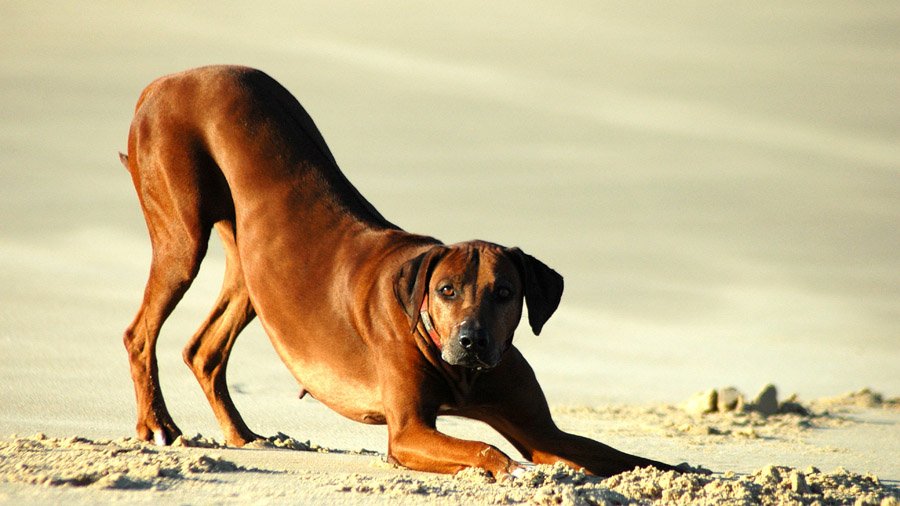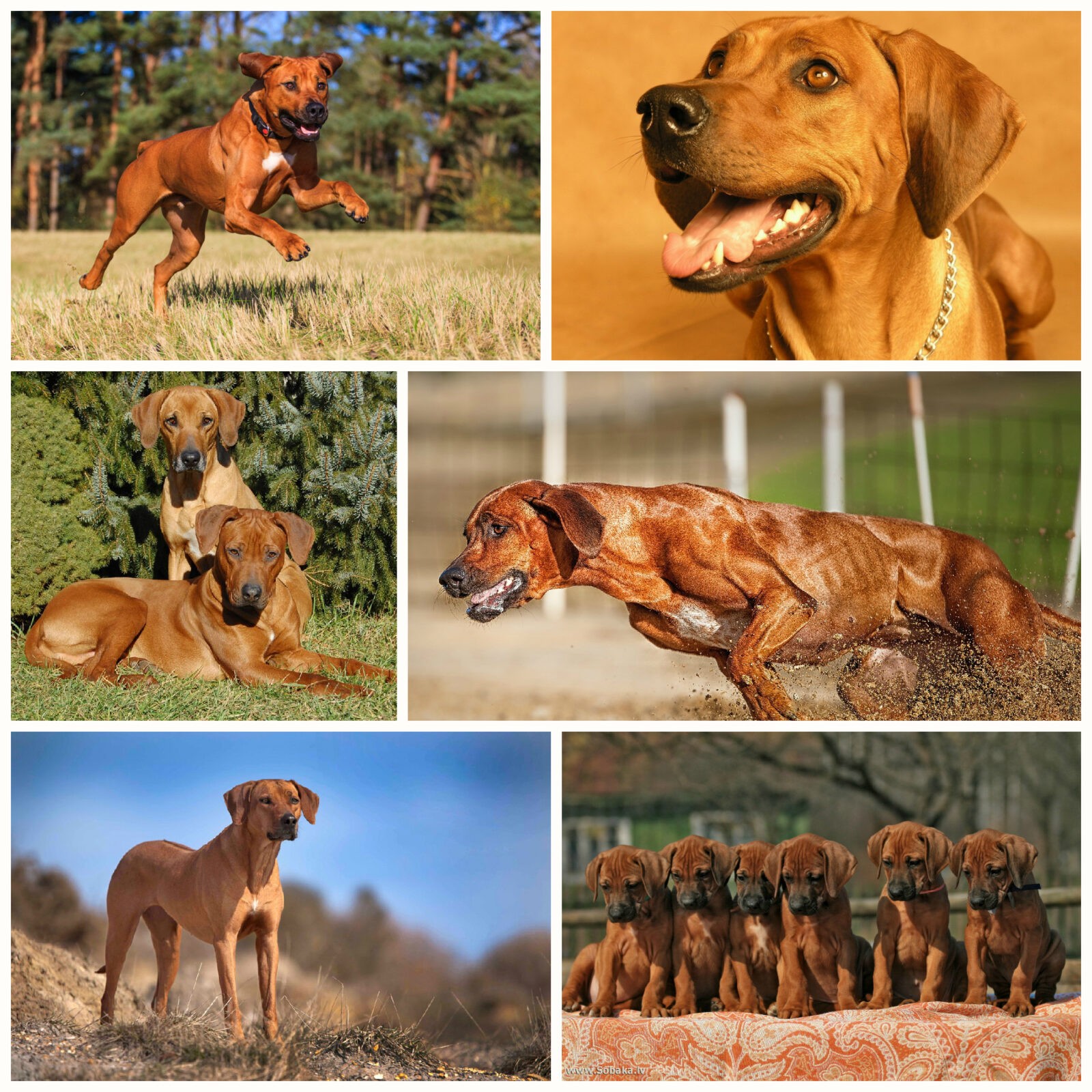The Rhodesian Ridgeback is the only South African dog breed to be recognized by the Fédération Cynologique Internationale. A distinctive feature of these dogs is the presence of a ridge (from the English "ridge" - "comb") - a strip running just below the withers, not reaching the level of the femurs, ideally having a symmetrical cone shape with characteristic curls at the point of narrowing of the ridge (comb) . The hair of the comb grows in the opposite direction relative to the hairline on the dog's body.

Brief description of the breed
Initially, Rhodesian Ridgebacks, related to hounds, participated in hunting game, guarded livestock during grazing, and guarded human habitation. And today this dog is quite versatile, in addition to the listed features (hunter dog, watchman, security guard) Ridgebacks show remarkable results during the capture of criminals while serving in the police in European countries. Ridgebacks are often bred with the aim of finding a companion dog, since these animals have a lively mind, a fairly balanced disposition, they do not differ in unreasonable aggression towards people, but they can stand up for the owner and his house. Ridgebacks are quite beautiful, tall (males reach 70 cm, females up to 66 cm), strong and muscular dogs. Their weight is from 30 to 37 kg.
Head: Skull of medium size, wide between the ears. Muzzle: The eyes of the dog are set relatively far apart, round in shape. The nose has a black or brown tint, and with a black lobe, the dog's eyes have a darker shade than with a brown nose, when the eyes are yellow. The cheekbones of the dog are not very pronounced. Scissor bite, lips dense, dark shade. The ears are set high, hanging close to the head, wide at the base, tapering towards the tips. Neck: Strong, without dewlap. Body: deep chest, powerful, muscular body, somewhat curved in the lumbar region. Limbs: Straight, bony, with well developed muscular shoulders and hips. Feet are compact and rounded. Tail: tapering towards the end, of medium length. Somewhat curved, but not curled into a ring on the back. Middle position. Coat: short, thick, shiny, medium hardness. Color: from light wheaten to dark red. Sometimes ridgebacks have dark markings (mask) in the muzzle and ears. Small white markings on the chest and toes are acceptable.
basic information
| Breed name: | Rhodesian Ridgeback |
| Country of origin: | Rhodesia |
| The time of the birth of the breed: | beginning of our era |
| Type of: | hounds and related breeds |
| The weight: | 30 - 37 kg |
| Height (height at the withers): | 61 - 70 cm |
| Life Expectancy: | 10 – 12 years old |
|
ICF classification:
|
Group 6, Section 3, Number 146 |
| Puppies price: | 300 – 1100 $ |
| Most popular nicknames: | List of nicknames for the Rhodesian Ridgeback |
Assessment of breed characteristics
| Adaptability
(a definition meaning how easily a dog can adapt to changes in life) |
🐶🐶🐶🐶 |
| Shedding level
(Level and frequency of hair loss in the animal) |
🐶🐶 |
| Tenderness level
(The level and amount of tenderness and affection that the dog gives in return for attention to itself) |
🐶🐶🐶🐶🐶 |
| Exercise needs
(Dog's daytime activity level) |
🐶🐶🐶🐶 |
| Social need
(The required number of contacts of the dog with other animals, as well as people) |
🐶🐶🐶🐶 |
| Apartment content
(A factor that determines the level of noise and other inconveniences that a dog can deliver to owners in relation to the size of the apartment to the size of the dog) |
🐶🐶🐶 |
| Grooming
(The number of bathing, brushing, and the number of professional grooming sessions required for the dog) |
🐶 |
| Friendliness in an unfamiliar environment
(Features of the behavior of a dog in a society with strangers or in an unfamiliar environment) |
🐶🐶 |
| Tendency to bark
(Tendency to bark and its frequency and volume) |
🐶 |
| Health issues
(Potential health status of the dog) |
🐶🐶🐶 |
| Territoriality
(The dog's tendency to protect his home, yard, or even his owner's car) |
🐶 |
| Friendliness to cats
(Tendency towards tolerance of cats and reduced expression of hunting instincts) |
🐶🐶 |
| Intelligence
(The ability of the dog to think and solve emerging difficulties (not to be confused with learning!) |
🐶🐶🐶🐶🐶 |
| Education and training
(The level of difficulty in training the dog to perform certain actions) |
🐶🐶🐶🐶 |
| Friendliness to children
(A factor that determines how friendly a dog is to children, whether he likes to play with them and tolerate some childish pranks) |
🐶🐶🐶🐶🐶 |
| Game activity
(The concept is determined by its very name, and, as a rule, is found in almost all dogs) |
🐶🐶🐶🐶 |
| Observation
(The ability of a dog to detect the presence of a stranger on its territory) |
🐶 |
| Friendliness to other dogs
(The tendency of the dog to find common language with his other relatives) |
🐶🐶 |
Photo of the Rhodesian Ridgeback:

Origin story
Personality of the Rhodesian Ridgeback
Maintenance and care
Training and education of Rhodesian Ridgeback dogs
From the appearance of a ridgeback baby in the house, its owner needs to behave with the dog in such a way that, growing up, she understands who is in charge in the “owner-dog” relationship. Excessive softness and permissiveness will make the Ridgeback wayward, obeying only his own opinion and his desires. Independence is already laid in the blood of these dogs, so you should not indulge even a small puppy when he climbs on the sofa, begs for food from the table, jumps on the owner in a fit of joy (in childhood, Ridgeback puppies are quite playful). It is better if such a dog has a fairly strict person who knows how to stand his ground as the owner.
Dog trainers note that although Ridgebacks are wayward, they learn willingly, they grasp commands very quickly. But for the correct training process, it is necessary to establish contact with the dog. For a comfortable stay of a dog in society, owners are advised to take a General training course with Rhodesian Ridgebacks on a special training ground under the supervision of a professional, remembering the training methods.
Rhodesian Ridgebacks are dogs with the blood of hunters in their veins, in addition, they are very strong and strong. Therefore, street cats, small dogs can easily be attacked by an untrained ridgeback. Untrained dog will pull the owner on a leash wherever she wants. That is, when acquiring such an animal, one should always be aware that socialization, training and training are necessary for it. And one should think about hunting for hunting only when the owner plans to introduce such a dog to the extraction of wild animals.
Health and disease of the Rhodesian Ridgeback breed
Some interesting facts
- In Russia, the Rhodesian Ridgeback dog breed appeared relatively recently - the first male and female were imported from the United States in 1993. A year later, on November 1, 1994, 5 Ridgeback puppies were born in the first litter. The first exhibition of the National Club of Rhodesian Ridgebacks in our country took place in 1999, where the presidents of ridgeback clubs from South Africa, the homeland of these dogs. Many of the Rhodesians born in Russia have become World and European Champions.
- The visiting card of the Rhodesian Ridgeback is their crest, the parameters of which are described in detail in the Standard breeds dated December 10, 1995. It happens that in the litter there is one or more puppies without a ridge-ridge at all. This serves as a reason for refusing the participation of such dogs in the exhibition business, since not only the absence of the ridge, but also some defects in its shape (asymmetry, short length, etc.) are disqualifying features of the breed. However, without the notorious ridge, the Rhodesian Ridgeback does not cease to be one. And the best qualities of the breed are preserved without a mark on the back - intelligence, endurance, calmness towards people and devotion to the owner.
Nurseries and breeders
We borrowed material from the wonderful site of our partners DOGCATFAN.COM about cats and dogs, the author dogcatfan
